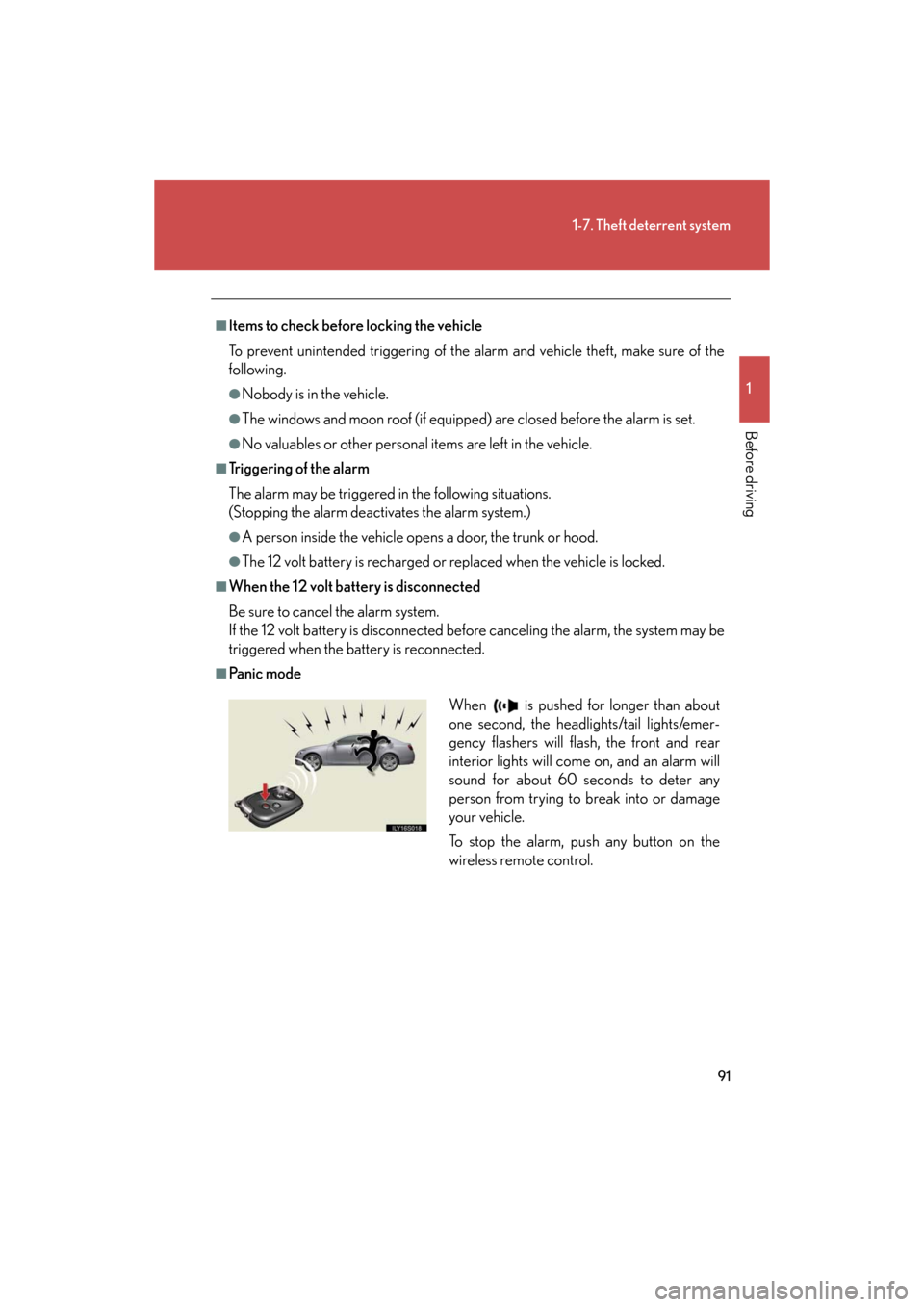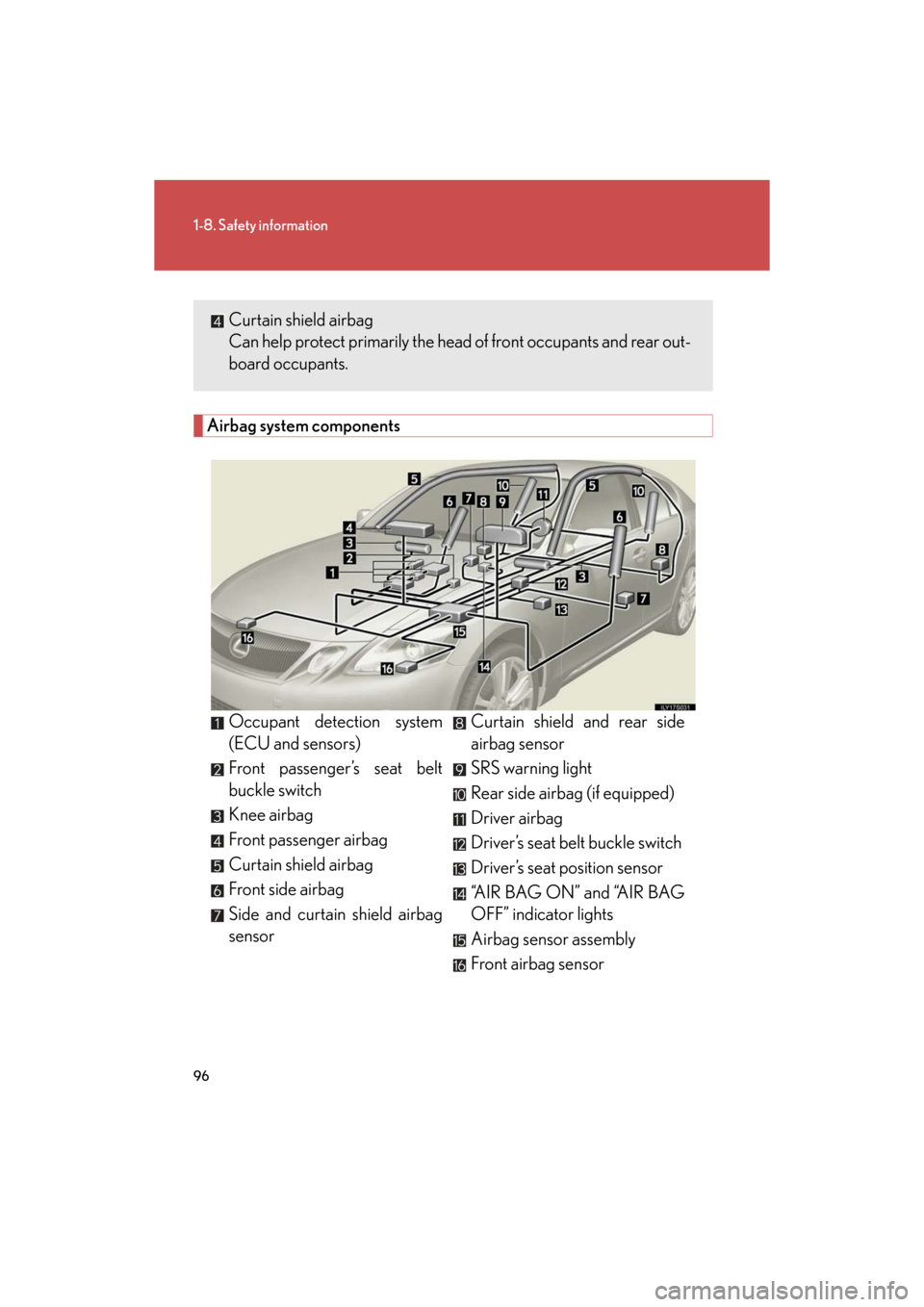Lexus GS450h 2008 Using the audio system / LEXUS 2008 GS450H (OM30A96U) Owners Manual
Manufacturer: LEXUS, Model Year: 2008, Model line: GS450h, Model: Lexus GS450h 2008Pages: 596, PDF Size: 9.36 MB
Page 91 of 596

91
1-7. Theft deterrent system
1
Before driving
GS_HV_U
December 12, 2007 3:30 pm
■Items to check before locking the vehicle
To prevent unintended triggering of the alarm and vehicle theft, make sure of the
following.
●Nobody is in the vehicle.
●The windows and moon roof (if equipped) are closed before the alarm is set.
●No valuables or other personal items are left in the vehicle.
■Tr i g g e r i n g o f t h e a l a r m
The alarm may be triggered in the following situations.
(Stopping the alarm deactivates the alarm system.)
●A person inside the vehicle opens a door, the trunk or hood.
●The 12 volt battery is recharged or replaced when the vehicle is locked.
■When the 12 volt battery is disconnected
Be sure to cancel the alarm system.
If the 12 volt battery is disconnected before canceling the alarm, the system may be
triggered when the battery is reconnected.
■Pa n i c m o d e
When is pushed for longer than about
one second, the headlights/tail lights/emer-
gency flashers will flash, the front and rear
interior lights will come on, and an alarm will
sound for about 60 seconds to deter any
person from trying to break into or damage
your vehicle.
To stop the alarm, push any button on the
wireless remote control.
Page 92 of 596

92
1-7. Theft deterrent system
GS_HV_U
December 12, 2007 3:30 pm
Theft prevention labels (U.S.A.)
These labels are attached to the
vehicle to reduce vehicle theft
by facilitating the tracing and
recovery of parts from stolen
vehicles. Do not remove under
penalty of law.
Page 93 of 596

93
1
Before driving
GS_HV_U
December 12, 2007 3:50 pm
1-8. Safety information
Correct driving posture
Drive with a good posture as follows:
Sit upright and well back in
the seat. (P. 58)
Adjust the position of the seat
forward or backward to
ensure the pedals can be
reached and easily
depressed to the extent
required. ( P. 58)
Adjust the seatback so that
the controls are easily opera-
ble.
Adjust the tilt and telescopic
positions of the steering
wheel downward so the air-
bag is facing your chest.
( P. 7 3 )
Lock the head restraint in
place with the center of the
head restraint closest to the
top of your ears. ( P. 6 4 )
Wear the seat belt correctly.
( P. 66)
Page 94 of 596

94
1-8. Safety information
GS_HV_U
December 12, 2007 3:50 pm
CAUTION
■While driving
●Do not adjust the position of the driver’s seat.
Doing so could cause the driver to lose control of the vehicle.
●Do not place a cushion between the driver or passenger and the seatback.
A cushion may prevent correct posture from being achieved, and reduce the
effectiveness of the seat belt and head re straint, increasing the risk of death or
serious injury to the driver or passenger.
●Do not place anything under the front seats.
Objects placed under the front seats may become jammed in the seat tracks and
stop the seat from locking in place. This may lead to an accident. The adjustment
mechanism may also be damaged.
■Adjusting the seat position
●Take care when adjusting the seat position to ensure that other passengers are
not injured by the moving seat.
●Do not put your hands under the seat or near the moving parts to avoid injury.
Fingers or hands may become jammed in the seat mechanism.
Page 95 of 596

95
1
1-8. Safety information
Before driving
GS_HV_U
December 12, 2007 3:50 pm
SRS airbags
The SRS airbags inflate when the vehicle is subjected to certain types of
severe impacts that may cause signific ant injury to the occupants. They
work together with the seat belts to he lp reduce the risk of death or serious
injury.
Front airbags
Driver airbag/front passenger airbag
Can help protect the head and ches t of the driver and front passen-
ger from impact with interior components.
Knee airbag
Can help provide driver and front passenger protection.
Side and curtain shield airbags
Front side airbag/rear side airbag (rear side airbags are optional)
Can help protect the torso of th e front occupants and rear out-
board occupants.
Page 96 of 596

96
1-8. Safety information
GS_HV_U
December 12, 2007 3:50 pm
Airbag system components
Occupant detection system
(ECU and sensors)
Front passenger’s seat belt
buckle switch
Knee airbag
Front passenger airbag
Curtain shield airbag
Front side airbag
Side and curtain shield airbag
sensorCurtain shield and rear side
airbag sensor
SRS warning light
Rear side airbag (if equipped)
Driver airbag
Driver’s seat belt buckle switch
Driver’s seat position sensor
“A I R B A G O N ” a n d “A I R B A G
OFF” indicator lights
Airbag sensor assembly
Front airbag sensor
Curtain shield airbag
Can help protect primarily the head of front occupants and rear out-
board occupants.
Page 97 of 596

97
1-8. Safety information
1
Before driving
GS_HV_U
December 12, 2007 3:50 pm
Your vehicle is equipped with “ADVANCED AIRBAGS” designed based
on US motor vehicle safety standards (FMVSS208). The airbag system
controls airbag deployment power for the driver and front passenger. The
driver airbag system consist s of the driver’s seat position sensor etc. The
front passenger’s airbag system consist s of the front passenger occupant
classification sensor etc.
The main SRS airbag system componen ts are shown above. The SRS air-
bag system is controlled by the airb ag sensor assembly. The airbag sen-
sor assembly consists of a safing sensor and an airbag sensor.
In certain types of severe frontal or side impacts, the SRS airbag system
triggers the airbag inflators. A chemica l reaction in the inflators quickly
fills the airbags with non-toxic gas to he lp restrain the motion of the occu-
pants.
■If the SRS airbags deploy (inflate)
●Bruising and slight abrasions may result from contact with a deploying (inflating)
SRS airbag.
●A loud noise and white powder will be emitted.
●Parts of the airbag module (steering wheel hub, airbag cover and inflator) as
well as the seats, and parts of the front pillar and roof side rail, may be hot for
several minutes. The airbag itself may also be hot.
●The windshield may crack.
Page 98 of 596

98
1-8. Safety information
GS_HV_U
December 12, 2007 3:50 pm
■Operating conditions (front airbags)
●The SRS front airbags will deploy if the severity of the frontal impact is above the
designed threshold level, comparable to an approximate 15 mph (25 km/h) col-
lision when the vehicle impacts straight into a fixed barrier that does not move
or deform.
However, this threshold velocity will be considerably higher if the vehicle strikes
an object, such as a parked vehicle or sign pole, which can move or deform on
impact, or if the vehicle is involved in an underride collision (e.g. a collision in
which the front of the vehicle “underrides”, or goes under, the bed of a truck, etc.).
●It is possible that in some collisions where the forward deceleration of the vehi-
cle is very close to the designed thresh old level, the SRS front airbags and the
seat belt pretensioners ma y not activate together.
●The SRS front passenger airbags will not activate, if there is no passenger sitting
in the front passenger seat. However, th e front passenger airbag may deploy, if
the heavy luggage is put in the seat , even if the seat is unoccupied.
■Operating conditions (side and curtain shield airbags)
●The SRS side airbags and curtain shield ai rbags are designed to inflate when the
passenger compartment is subjected to a severe impact from the side.
●The SRS front side airbag on the passenger seat will not activate if there is no
passenger sitting in the front passenger seat. However, the front side airbag on
the passenger seat may deploy if the heavy luggage is put in the seat, even if the
seat is unoccupied. ( P. 1 0 7 )
Page 99 of 596

99
1-8. Safety information
1
Before driving
GS_HV_U
December 12, 2007 3:50 pm
■Conditions under which the SRS airbags may deploy (inflate), other than a colli-
sion
The SRS front airbags may also deploy if a serious impact occurs to the underside of
your vehicle. Some examples are shown in the illustration.
■Types of collisions that may not de ploy the SRS airbag (front airbags)
The SRS front airbags are generally not designed to inflate if the vehicle is involved
in a side or rear collision, if it rolls over, or if it is involved in a low-speed frontal colli-
sion. But, whenever a collision of any type causes sufficient forward deceleration of
the vehicle, deployment of th e SRS front airbags may occur.
●Hitting a curb, edge of pavement or hard
surface
●Falling into or jumping over a deep hole
●Landing hard or vehicle falling
●Collision from the side
●Collision from the rear
●Vehicle rollover
Page 100 of 596

100
1-8. Safety information
GS_HV_U
December 12, 2007 3:50 pm
■Types of collisions that may not deploy the SRS airbag
(side and curtain shield airbags)
The SRS side airbag and curtain shield ai rbag system may not activate if the vehicle
is subjected to a collision from the side at certain angles, or a collision to the side of
the vehicle body other than the passenger compartment.
The SRS side airbags and curtain shield airbags are generally not designed to
inflate if the vehicle is involved in a frontal or rear collision, if it rolls over, or if it is
involved in a low-speed side collision.
●Collision from the side to the vehicle body
other than the passenger compartment
●Collision from the side at an angle
●Collision from the front
●Collision from the rear
●Vehicle rollover